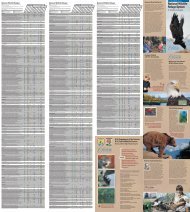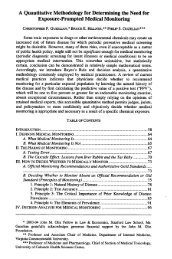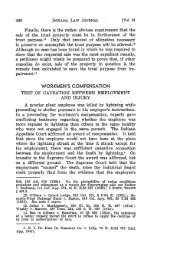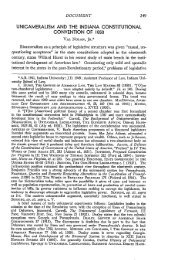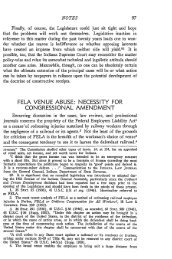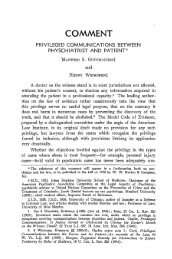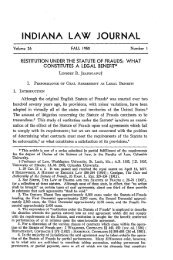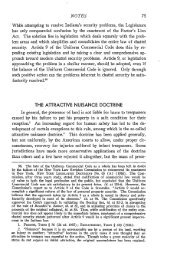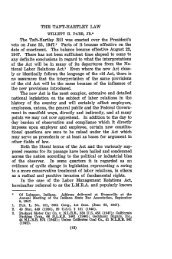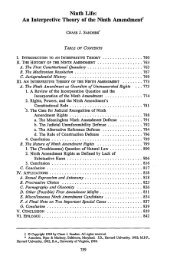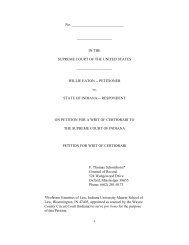Bridgeport Music v. Dimension Films - Indiana University School of ...
Bridgeport Music v. Dimension Films - Indiana University School of ...
Bridgeport Music v. Dimension Films - Indiana University School of ...
You also want an ePaper? Increase the reach of your titles
YUMPU automatically turns print PDFs into web optimized ePapers that Google loves.
436 INDIANA LAW JOURNAL [Vol. 81:435<br />
<strong>Bridgeport</strong> <strong>Music</strong>, Inc. v. <strong>Dimension</strong> <strong>Films</strong>, 7 the Sixth Circuit held that the de minimis<br />
doctrine was inapplicable where there was digital sampling <strong>of</strong> a sound recording<br />
protected by a valid copyright. 8<br />
Around the same time as the <strong>Bridgeport</strong> decision, the Ninth Circuit, in Newton v.<br />
Diamond, 9 had an opportunity to address a similar sampling issue involving a musical<br />
composition, and concluded that a three-note sequence with one background note was<br />
de minimis. 10 These two cases indicate a circuit split over how sampling should be<br />
treated under copyright law. This circuit split is important because, while both cases<br />
involved copyrightable subject matter and the standards for infringement should apply<br />
equally to both, the <strong>Bridgeport</strong> court’s ruling would mean that one type <strong>of</strong> subject<br />
matter, sound recordings in particular, would be treated differently and in fact given<br />
more protection than other types <strong>of</strong> subject matter, including literary works, films, and<br />
musical compositions. This circuit split is all the more important because <strong>of</strong> the dearth<br />
<strong>of</strong> legal precedent relating to digital sampling <strong>of</strong> sound recordings in particular. 11 In<br />
reality, however, sampling has been with us throughout history—the only difference is<br />
the advanced computer s<strong>of</strong>tware and equipment that make the process easier and more<br />
direct. 12 Indeed, sampling can be likened to “quoting” the idea contained within the<br />
few notes borrowed from the original whole. 13 Thus, as this Note will show, cases<br />
involving sampling can be analogized to those involving other copyrightable subject<br />
matter, and should not be treated differently.<br />
The factual similarities <strong>of</strong> the Newton and <strong>Bridgeport</strong> cases allow a closer<br />
examination <strong>of</strong> the problem that digital sampling presents to copyright law. In Newton,<br />
the plaintiff, a flutist 14 and composer, sued the rap group the Beastie Boys for<br />
7. 383 F.3d 390 (6th Cir. 2004), aff’d on reh’g, 410 F.3d 792 (6th Cir. 2005).<br />
8. Id. at 396. In that case, the sample in question was three notes long. In contrast, the<br />
Supreme Court has traditionally refused to rule there is no de minimis defense or exception<br />
available, except in cases <strong>of</strong> constitutional violations. See, e.g., Elk Grove Unified Sch. Dist. v.<br />
Newdow, 124 S. Ct. 2301, 2323 (2004) (“There are no de minimis violations <strong>of</strong> the<br />
Constitution—no constitutional harms so slight that the courts are obliged to ignore them.”);<br />
Lorillard Tobacco Co. v. Reilly, 533 U.S. 525, 567 (2001) (“There is no de minimis exception<br />
for a speech restriction that lacks sufficient tailoring or justification.”).<br />
9. 388 F.3d 1189 (9th Cir. 2004), cert. denied, 125 S.Ct. 2905 (2005).<br />
10. Id. The Newton court’s holding regarding the originality <strong>of</strong> the portion sampled will be<br />
discussed in Part I.C and Part III.A, infra.<br />
11. See <strong>Bridgeport</strong>, 383 F.3d at 400 (noting lack <strong>of</strong> judicial precedent); Stephen R. Wilson,<br />
<strong>Music</strong> Sampling Lawsuits: Does Looping <strong>Music</strong> Samples Defeat the De Minimis Defense?, 1 J.<br />
HIGH TECH. L. 179, 180 (2002) (noting the circular problem that occurs where many sampling<br />
cases are settled out <strong>of</strong> court because lack <strong>of</strong> precedent makes court unpredictable).<br />
12. See generally Robert M. Szymanski, Audio Pastiche: Digital Sampling, Intermediate<br />
Copying, Fair Use, 3 UCLA ENT. L. REV. 271, 272–89 (1996) (discussing the technique and<br />
history <strong>of</strong> digital sound sampling).<br />
13. See Williams v. Broadus, No. 99 Civ. 10957 MBM, 2001 WL 984714, at *3 n.6<br />
(S.D.N.Y. 2001).<br />
14. There is some debate over whether the term “flutist” or “flautist” is correct. The district<br />
court used the term “flautist.” Newton v. Diamond, 204 F. Supp. 2d 1244, 1252 (C.D. Cal.<br />
2002), aff’d, 388 F.3d 1189 (9th Cir. 2004), cert. denied, 125 S.Ct. 2905 (2005). The court <strong>of</strong><br />
appeals, however, used the term “flutist.” Newton, 388 F.3d at 1191. This Note will use the term<br />
“flutist,” as this is the term Newton uses in his briefs and court documents. See, e.g., Petition for



